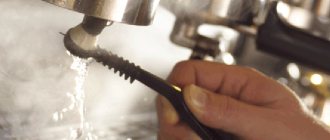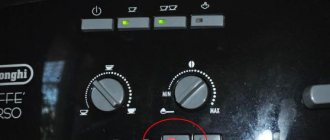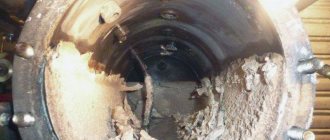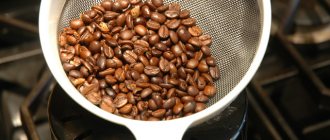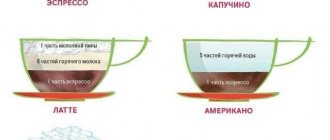The main problem that Turkish coffee owners have is the formation of coffee deposits inside. The appearance is often spoiled by black soot. A green coating appears on copper vessels due to oxidation under the influence of moist air.
The choice of cleaning method depends on the material. Stainless steel and many ceramics are dishwasher safe. The wooden handle is pre-unscrewed. After cooling, coffee pots are washed by hand with warm water, wiping off dirt with a sponge. Abrasive cleaning products are not recommended.
How to clean a Turk from dirt from the outside
If the question is raised, it is obvious that using standard dishwashing products is unacceptable.
The cost of even a modern copper Turk is such that it is worth spending money on the most expensive chemicals before cleaning a copper Turk at home. In fact, costs can be reduced to zero, because the best products for cleaning copper products can probably be found in every home. Incredible? No, fact!
- Citric acid or pure natural lemon juice.
- Table, 9% solution of food vinegar.
- Baking soda.
- Fine table salt (Extra grade).
- Ammonia.
- Tooth powder or paste.
As you can see, the list does not include household chemicals that are so persistently advertised on television. But everything listed is quite accessible and you will certainly find at least something from the list in your home. All methods are almost identical in effectiveness and safety, choose at your own discretion, but we will definitely give you some advice.
Before cleaning a copper pot at home, be sure to wash it! There is no need to use detergents, as already mentioned, just hot water is enough. Next, we wipe and dry the Turk; all that remains is to choose a cleaning method.
There are many different options for cleaning copper products:
- chemical - using acid - lemon juice, tomato ketchup, brine, whey, vinegar, ammonia,
- abrasive - using crushed chalk, soda, flour, GOI paste.
It is important to remember that you cannot use aggressive substances such as oxalic or hydrochloric acid, as they can damage the product.
How to clean a copper pot using chemical methods using household acids? Some of them are described below.
Lemon juice or citric acid:
- The outer surface of the copper cezve is rubbed with the juice of half a lemon, sprinkled with fine salt, or a solution of citric acid (2 teaspoons of citric acid per 200 ml of water).
- Leave the solution for two to three minutes (no more, otherwise dark spots will remain from prolonged exposure to acid).
- Rub the solution with a brush.
- Rinse thoroughly with warm water.
- Wipe the cleaned surface of the Turk dry with a cloth.
- Polished.
Table vinegar and salt.
How to clean a copper cezve from plaque using a “scrub” of vinegar and table salt:
- Prepare a mixture of a spoonful of salt and two tablespoons of vinegar.
- Apply to the surface of a copper product.
- Treat the surface of the Turk with this product using a brush.
- After cleaning, the scrub is washed off with warm water.
- Wipe the product dry and polish it.
Vinegar dough.
You can effectively clean copper objects with engraving or embossing, including a Turk, using a composition made from two tablespoons of flour and 50 ml of vinegar:
- The resulting pasty mixture is applied to the surface.
- Leave for 20-30 minutes until dry.
- Treat the surface with a brush.
- After cleaning, the composition is washed off with warm water, and the surface is dried and polished.
You can remove plaque and clean copper using regular tomato sauce, which contains various natural acids, including citric acid.
This product allows you not only to thoroughly wash the Turk, but also to give it a natural copper tint and shine. You can even use expired sauce for cleaning.
Apply ketchup or brine:
- Ketchup is applied to the outer walls of the Turk.
- Leave it for two to three minutes.
- Clean the surface with a brush.
- Wash off the composition after cleaning the Turk, dry it and polish it.
Instead of ketchup, you can use brine from sauerkraut, cucumbers or tomatoes.
Ammonia is ideal for removing old and difficult to remove stains.
However, when working with it you must follow these rules:
- cleaning must be carried out in a spacious, well-ventilated area,
- Protect the skin of your hands with gloves,
- After cleaning, thoroughly wash off any remaining product with soap and water.
https://www.youtube.com/watch?v=zMTKz5FMZpA
How to clean copper products using ammonia:
- Prepare a mixture of ammonia (one part) and water (two parts).
- Moisten the surface of the cezve with the resulting solution.
- Thoroughly wipe the surface of the dishes and remove dirt.
- Be sure to wash the dishes thoroughly using soap or other detergent.
In some cases, owners of copper products prefer to use dry abrasive treatment to clean the product.
Key points when working with copper products in case of dry cleaning:
- place the abrasive agent on a soft cloth,
- Clean the surface of the product in a circular motion.
After finishing the treatment, rinse the Turk with water, dry and polish.
There are many different options for cleaning copper products:
- chemical - using acid - lemon juice, tomato ketchup, brine, whey, vinegar, ammonia;
- abrasive - using crushed chalk, soda, flour, GOI paste.
Ammonia - this product is ideal for removing old and difficult to remove stains.
However, when working with it you must follow these rules:
- cleaning must be carried out in a spacious, well-ventilated area;
- Protect the skin of your hands with gloves;
- After cleaning, thoroughly wash off any remaining product with soap and water.
Key points when working with copper products in case of dry cleaning:
- place the abrasive agent on a soft cloth;
- Clean the surface of the product in a circular motion.
All coffee lovers who value preparing a drink in a copper pot are faced with the problem of darkening the walls of the cezve. Copper tends to oxidize, causing plaque to appear, and soot from the furnace leaves its traces over time. The inside walls are covered with a coffee coating, which negatively affects the taste of freshly brewed coffee. To ensure that the process of preparing your favorite drink brings pleasure and delights with aromatic results, the vessel must be cleaned regularly.
Of course, you can buy specialized products for caring for copper cookware and spend a considerable amount. But these expenses may be unnecessary, because you can clean a copper pot well using improvised means available in almost every home.
All methods can be divided into 2 groups: acid and abrasive. The difference lies in the cleaning agent used. Let's look at the simplest and most accessible life hacks.
For many, Turka is not just dishes, but a special attribute for creating a specific atmosphere, which, moreover, makes the owner a real ace of “coffee” affairs. Therefore, its appearance is of great importance: if it is dotted with burnt spots from escaped and burnt coffee, traces of carbon deposits from a gas oven, then a corresponding impression is created.
Copper products have long been recognized by connoisseurs of high-quality and reliable things. In modern life there are many items based on copper alloy. These are dishes, figurines, coins, decorative items, and jewelry. All these products not only look elegant, but are also quite durable. In addition, copper objects have a positive effect on human health.
However, over time, a variety of contaminants may appear on copper products - green, brown or yellow deposits. Turkish users are well aware of this problem. Today we will tell you how to clean a copper pot at home with maximum efficiency and minimal cost.
We invite you to familiarize yourself with Step-by-step cleaning of a shower stall - effectively!
Our ancestors also used copper basins to make jam. It was believed that in this dish the product was richer and healthier. And today, many housewives prefer to have copper alloy cookware in the kitchen, since the thermal conductivity properties of copper help cook food faster and tastier.
To ensure that your products always look clean and luxurious, follow these simple rules:
- Do not use abrasives when cleaning copper alloy items.
- When cleaning, use only a soft cloth or sponge.
- Polish items frequently. This will help increase their service life.
- Do not store food in copper containers, as this leads to oxidation of the alloy and reduces the service life of the product.
- Store copper items in a dry place. Moisture provokes oxidation of the metal.
- After using the Turk, be sure to give it time to cool. Never pour cold water into a still hot dish, as this will damage the metal.
- After using any cleaning method, rinse or boil the dishes and wipe dry.
There are time-tested products for each type of cleaning. Today we will talk not only about general methods for cleaning copper objects, but also share tips on caring for a Turk.
If you regularly use a Turk to make coffee, then you often have to remove accumulated dirt from its surface. Inside there is a coffee residue, and outside there is soot from the flame of a gas stove. And if deposits on the outer surface do not spoil the taste of coffee, then internal deposits can change the smell of the drink. Next, we will tell you how to clean a copper Turk both inside and out while maintaining the integrity of the coating.
With lemon
How to clean a copper pot at home
Lovers of aromatic grain coffee who prefer to brew it in a Turkish coffee pot are well aware that the most suitable material for it is copper: it is healing and has a beneficial effect on the body, enriches the taste of products. But in the process of using the dishes, dirt accumulates on them and the shine disappears. Using various means that are usually available in the arsenal of a skillful housewife, you can clean a copper Turk at home.
How to clean the outside of a copper pot
If you use a Turk for a long time, it darkens due to the fact that the metal oxidizes and soot remains from the fire.
Since ancient times, cleaning copper did not require any special means - those that are usually always at hand cope well with stains:
- with kerosene (for example, basins, which were widely used for making jam) - they wiped the surface with it, after which they rubbed it with powdered chalk, and then with a woolen rag;
- Lemon is great for cleaning. The dishes should be wiped dry, sprinkled with fine salt and wiped on the outside with cut citrus halves, and then cleaned with a cloth. Washed with water and polished with flannel, the Turk will shine like new.
Vinegar and salt
If there are no citruses and citric acid in the kitchen, they resort to acetic acid (not higher than 6 percent).
Mix finely ground salt (a tablespoon) with a couple of tablespoons of vinegar until it becomes mushy. Apply the mixture to the metal surface of the Turk with a sponge and clean it.
In case of severe contamination, leave the paste for 15 minutes. The cezve is washed and dried, and if desired, polished to a shine.
By heating the vessel in a weak vinegar-salt solution (a spoonful of salt per glass), you can achieve the dissolution of the oxides in a quarter of an hour.
A vinegar dough made from 2 tablespoons of flour and half a glass of vinegar copes well with the problem.
The mixture is kneaded so that no lumps form, and the outer part of the dish is coated with it. Use a medium-hard toothbrush to clean the bowl.
The bristles of the brush clean even hard-to-reach places - for example, where there is engraving.
Brine
Brine from sauerkraut, tomatoes and cucumbers is successfully used to purify metals.
To wash the Turk, you need to immerse it in salted liquid for 6 minutes or wrap it in a piece of cloth soaked in brine.
The saline solution removes dirt deposits, then you just need to wash them off with soap and water.
Dry cleaning of copper Turks
Abrasives should also be used to clean the bowl, the main thing is that the products do not contain large fractions. Suitable cleaners include:
- chalk;
- dentifrice;
- flour.
The chalk is crushed and poured onto soft cloth, after which the surface is rubbed, rinsed and dried. Do the same with tooth powder and flour.
How to clean the inside of a copper pot
The inside of the Turk also becomes dirty from burnt coffee.
Housewives are wondering how to clean a copper pot if the cookware is designed in such a way that the neck is narrow and it is difficult to reach the bottom. However, there is a way to solve the problem.
You will need:
- large saucepan;
- soda (1 spoon per liter of water);
- grated laundry soap (2 tablespoons per liter of water).
If there is too much plaque on the inner surface, you can add citric acid or vinegar.
All components are mixed, placed on the stove and immersed in a Turk pan.
When it boils, reduce the flame to low and simmer for another half hour.
After removing the container from boiling water, clean it from the inside with a brush until the plaque comes off.
How to properly care for copper items
The cookware will serve you faithfully for a long time if you follow simple rules for caring for a copper pot:
- When removing a vessel from the fire, you should not immediately immerse it in cool water, since copper products tend to deteriorate due to sudden changes in temperature.
- The cezve is stored separately from other dishes so as not to scratch the walls.
- For storage, it is placed in a paper bag or wrapped in cloth.
- The container for brewing coffee is washed immediately after it is prepared so that plaque does not have time to stick.
- A poorly cleaned bottom is rubbed with a crushed powdery substance (salt, soda, chalk).
- You can polish the inside of the vessel with toothpaste without abrasive additives, and on the outside with black and white newspaper, rolled it into a ball. After this, you should rinse the product.
- Household chemicals are not recommended for cleaning Turks. It is also impossible to use oxalic or hydrochloric acid for this purpose - this is primarily dangerous for humans.
- You should also not clean copper with crushed bricks, coarse salt and sand, so as not to damage the soft walls of the cookware.
- Copper utensils are stored in a dry, ventilated area.
Source: https://steelfactoryrus.com/kak-pochistit-mednuyu-turku-v-domashnih-usloviyah/
How to wash the inside of a Turk
To maintain the integrity of the coating and remove dark deposits on the inside of the Turk, use gentle cleaning methods. This can be done using regular baking soda.
Proceed as follows:
- Select a large pot so that you can completely immerse the Turk in it.
- Fill the container with soda solution. For 1 liter of water - 1 tbsp. spoon of soda.
- Immerse the coffee pot in the solution.
- Place the pan on the stove and bring the water to a boil.
- Leave the dishes on low heat for 30 minutes. Regularly add new water as it boils, so that the coffee pot is completely immersed in the solution.
- Turn off the heat.
- Clean the inside of the Turk using a long-handled brush. To avoid burning your hands, hold the coffee pot by its handle.
- Remove the Turk from the pan.
- Wipe the product with a soft cloth and polish with a napkin until shiny.
The cezve gets dirty not only on the outside, but also on the inside from the coffee being prepared. The vessel has a narrow neck, so it is not easy to reach the bottom to clean it. It is especially difficult when the coffee is burnt and there is a black residue left at the bottom. So, let's find out how to cope with internal pollution.
- A saucepan (size enough to fit a Turk).
- Baking soda - at the rate of 1 tbsp. l. per liter of water.
- Liquid laundry soap or grated on a fine grater – 2 tbsp. l. per liter of water.
If the Turk is old and completely covered with a very strong coating, add acetic or citric acid to the water (2 tablespoons per 1 liter). Dissolve baking soda and soap in water and place the pan on the fire. When the water comes to a boil, place the Turk in it, reduce the heat to low and boil the product for 15-30 minutes (depending on the degree of contamination).
Then remove the coffee maker from the water (wear gloves to protect against burns) and use a brush to clean the inside of it. All dark plaque on the inside should come off easily, without much effort.
The Turk should be cleaned not only outside, but also inside
To clean the inside surface, use a sponge or cloth, as tin and silver are soft materials and require careful handling. Hard metal scrapers and abrasive sponges severely scratch the surface.
Coffee stains quickly disappear if you boil water with a quarter of a lemon in a vessel. After cleaning the Turk, rinse it well and dry it.
Write in the comments if our tips helped.
How to cook correctly
There is only one way to make coffee correctly - you need to feel what your tongue is saying when you taste the coffee. You also need to take a risk and change your cooking process, feel what your tongue “says” and write it down in a notebook.
Get a special notebook.
I have created a separate table for this in an electronic notebook, in this table you need to write down: how much coffee you put in, what grind you used, how much water you put in, how long the coffee was brewed, what feelings you experienced after tasting.
I have this table: when I brewed it, the name of the coffee, the grind number - the number that is on my manual coffee grinder, how much coffee I poured, how much water there was, and so on and so forth.
Please note, I cooked with only coffee but changed the grind each time, I tried to keep the rest of the things
Be sure to experiment.
Take a pack of any coffee and start brewing, select a recipe.
Increase the amount of coffee. Don’t change anything else, cook with the same grind, in the same Turk, on the same stove and in the same water. Write down your feelings and the recipe. Then do exactly the opposite. And write down your feelings again. Choose the most comfortable amount of coffee, and try not to make a mistake with the dosage.
Then change the grind. Make it thinner, then rougher. Write it down as you like.
The main thing in a coffee grinder is to grind evenly, grain to grain.
I know myself and my technique, so I long ago found my optimal dose of coffee. I experiment with the coffee itself or with grinding. Some coffee looks good in only one method of preparation, for example, there is an Italian Paganini blend, which is roasted in Russia by Sergei Tabera (he roasts for two stores and some coffee shops throughout Russia), this blend looks great in espresso. Turka, moka or other methods don’t look as cool, no matter how much I experiment.
And with grinding everything is easier. I have a coffee grinder that has 20 fine grind settings. I set the grind to 5 and cook the Turk, writing down the sensations. Then I cook it at 15 and write down the sensations. Then I compare notes. If the taste developed better at 15, then this coffee needs a coarser grind. Again I brew 2 Turks, but this time I put 12 and 17. If 12 showed itself better than 17 and better than 15, I leave 12. Then I drink the entire pack of coffee grinding 12. When I take a new pack of the same coffee or a completely different one coffee, experiments are repeated.
Not a single blade coffee grinder (such as a blender) can make an even grind; such things should be abandoned. However, cheap (under $100) burr coffee grinders cannot either.
In the same way, you can experiment with water or with the form of Turk. Some method will prove much better than others.
Brew the right coffee! Enjoy delicious coffee!
How and with what to clean the inner surface of the cezve
The inside of such cookware cannot be cleaned using the above methods. Coffee stains are best removed with baking soda.
I clean the inside of the Turk as follows:
- The dishes must be filled with water;
- add a tablespoon of baking soda;
- Boil this solution for fifteen minutes.
Using this method, coffee stains are effectively removed, and there is no need to use chemicals to clean dishes.
I clean the inside of the Turk as follows:
- The dishes must be filled with water,
- add a tablespoon of baking soda,
- Boil this solution for fifteen minutes.
Signs of a clogged coffee maker
When using water containing hardness salts, scale will inevitably form in the coffee maker. Both simple drip and capsule or carob coffee makers are susceptible to clogging.
Not all coffee makers are equipped with a built-in indicator (a counter for the number of cups of coffee brewed), so you need to be able to recognize signs of limescale deposits inside the machine:
- It takes longer to prepare one serving of drink than before;
- if the tube and outlet are clogged, the stream of ready-made coffee becomes thin, causing the cup to take longer to fill;
- the taste of the drink has deteriorated;
- there is a foreign smell;
- the operating device began to make unusual sounds;
- a light gray sediment is visible in the cup;
- Electricity consumption has increased while the coffee maker is operating.
According to repair specialists, boiler-type capsule and carob coffee makers are most susceptible to heater overgrowth and tube clogging. In devices with a thermoblock, water does not stagnate, and the process of scale formation proceeds more slowly.
If limescale deposits have appeared, you need to get rid of it, and descaling the coffee maker is also possible at home.
In very advanced cases, the coffee maker will have to be disassembled
How to properly care for copper items
In order for copper products to please their owners for a long time, it is important to properly and promptly care for them.
The following subtleties will help with this:
- You can polish the Turk using toothpaste.
- You can add shine to copper objects by wiping them with ordinary newspaper rolled up into a ball.
- It is not advisable to use coarse abrasive compounds to clean the product.
- Do not store food in copper containers.
- Products made of copper alloys should be stored only in a dry room.
It is important to remember that oxide on copper cookware is harmful to health!
It is important to remember that a hot Turk should never be filled with cold water. The dishes need to cool down after use, and then they can be washed. It is necessary to care for the copper Turk after each use. The cezve must be cleaned and wiped dry.
It is important to remember that a hot Turk should never be filled with cold water. The dishes need to cool down after use, and then they can be washed. It is necessary to care for the copper Turk after each use. The cezve must be cleaned and wiped dry.
Lemon acid
Copper utensils have been used by housewives for a very long time. Over the centuries, many cleaning methods have been invented, which can be combined into two groups:
- Cleaning using acidic medium.
- Cleaning with abrasive materials.
To wash a copper Turk, lemon (citric acid), vinegar, ammonia, whey from milk, tomato ketchup and natural abrasives are most often used.
Lemon or citric acid copes well with darkening of any complexity. Cleaning with lemon is only suitable for external surfaces.
We suggest you read: Is it possible to wash a jacket? We clean and wash jackets made from different materials
If you don’t have fresh fruit, citric acid is perfect. To do this, take 2 teaspoons, dilute in 200 ml of warm water and stir well until completely dissolved. After exposure to acids, the Turk is washed with plenty of running water.
The cleaning algorithm will be as follows:
- A large lemon is cut into two parts.
- The dry Turk is rubbed with one part of the lemon over the entire surface.
- Leave the coffee maker for a few minutes.
- Using an old toothbrush, spread the juice evenly and carefully over the surface.
- Rinse off under running water for several minutes.
- Wipe dry with a natural fiber cloth.
You can use citric acid or lemon juice. Thanks to the substances contained in these products, the plaque will quickly disappear.
You should proceed as follows:
- Half a citrus is sprinkled with salt and rubbed into the Turk. The cezve should be dry; there is no need to pre-moisten it.
- If you use citric acid, it must be dissolved in water. Make a concentrated product at the rate of 1 tbsp. l. for 1 glass of water. This way you can clean the dishes faster. Turku is soaked in this composition or simply wiped.
- After 2-3 minutes, take a soft brush, maybe a toothbrush, and rub the product over the entire surface, without missing a single area.
- The cleaned cezve is rinsed under running water and polished with a soft cloth.
It is not recommended to use citric acid or lemon too often. It is better to alternate them with other available means.
You can clean a heavily soiled Turk with a special mixture that you prepare yourself.
To prepare the composition you will need to mix 3 tbsp. l. turpentine, 4 tbsp. l. alcohol and 30 g of oxalic acid.
Use a rag soaked in the mixture to wipe the outside of the Turk. It is not recommended to use this composition for internal cleaning, but in extreme cases it is possible.
After removing all dirt, soot and burnt coffee, you can wash the product under running water. If you cleaned the inside with the mixture, wash it very well.
The ingredients used in cleaning may cause serious health problems.
The remaining mixture can be transferred to a bottle with a tight-fitting lid and stored in a dark place. Shelf life - no more than 2 months.
To clean the cezve, do not use abrasives or metal brushes. To increase the service life of the product, it must be cleaned after each coffee preparation and also polished.
Tips for cleaning copper must be followed unquestioningly if you want to extend the life of the Turks.
With lemon
- Cut the lemon into halves
- Rub the dry Turk over the entire surface with lemon
- Leave for a couple of minutes
- Gently rub the lemon juice over the surface with a brush.
- Wash off with plenty of warm water
- Wipe the surface thoroughly with a linen cloth
What do you need to know?
- Fresh lemon can be replaced with a solution of citric acid, in a ratio of 2 teaspoons per 200 ml of warm water.
- Acid can not only clean the copper surface, but also form dark spots on the copper with prolonged exposure, so you should not leave the Turk in the lemon compress for a long time.
- For the same reason, all traces of acid must be carefully removed.
The method of cleaning a copper Turk with lemon is only suitable for the outer surface of the Turk.
Do not wet the surface of the Turk with acetic acid to avoid excessive oxidation. The old recipe for vinegar dough will do a much better job of cleaning.
- Take about 50 ml of table vinegar (6-8%)
- Stir in flour, about 2 tablespoons.
- Generously coat the surface of the turk with the resulting mixture and leave until dry.
- Clean thoroughly with a dry brush.
- Rinse the Turk with warm water and wipe dry with a napkin.
- It is better to work with thin gloves so that the vinegar does not irritate the skin of your hands.
- Flour is needed in this recipe as a soft abrasive.
- This dough is effective for cezves that have engraving or embossing, as it removes dirt well in hard-to-reach recesses.
- It is convenient to use an old toothbrush as a brush.
Ammonia, also known as ammonia, is a very active chemical compound, so you need to work with it carefully. But this method is well suited for removing deep dirt, as well as for combating green spots.
- Dilute ammonia with water in a ratio of 1:2.
- Moisten the cotton wool generously with the resulting mixture.
- Use a swab to wipe the outer surface of the turk well.
- Wash dishes thoroughly with warm water and soap or a non-abrasive detergent.
- Wipe the Turk dry with a soft cloth.
https://www.youtube.com/watch?v=sjRRzRWatT8
Adviсe
- Ammonia binds oxidation products and pollution, forming an ammonia complex that is easily washed off with warm water and soap. Therefore, final processing of the Turks is mandatory.
- Ammonia has a pungent odor; you should work with it in a well-ventilated area and wear gloves.
- You can buy ammonia at any pharmacy.
The ancient method, which helped our grandmothers more than once, is quite effective for cleaning copper utensils today.
- Take one glass of whey and dissolve 1 full spoon of table salt in it.
- Soak a flannel napkin with the resulting solution.
- Clean the Turk thoroughly with a damp cloth.
- Cover heavily soiled areas with a cloth well moistened in the prepared solution and leave for 3-4 minutes. Then wipe again.
- After processing, rinse the Turk with warm water and wipe dry.
For good results
- It is better to take table salt of fine or medium grinding so that it dissolves well, saturating the solution.
- There should be no undissolved salt grains left on the napkin with which you will process the Turka.
- It is better to work with gloves.
Using ketchup
It contains citric acid and tomato paste, rich in natural acids. Therefore, if you have this food product on hand, feel free to use it for household purposes.
- Apply a layer of ketchup to the dry surface of the cezve.
- Leave for 2-3 minutes.
- Rinse with warm water and wipe dry with a napkin.
What to remember?
- The cheapest ketchup works best
- Turka will not only become cleaner, but will also restore its bright, copper color
- You can use expired ketchup
There are also more extreme means of acid cleaning of copper Turks. So, some advise using oxalic acid or even hydrochloric acid. But these tips are more suitable for very severe pollution with a long history. In ordinary life, it is better to avoid actions with such potent drugs, especially if you do not have the necessary skill.
Acidic
Basically, everyone is interested in the question of how to clean the outside of a copper pot, since an oxide layer forms on the surface of the metal. To do this, you can choose one of the following means:
Acid whey from milk. Liquid made from homemade milk works especially well.
Fresh lemon – you will need a couple of slices.
Old expired tomato ketchup.
Vinegar - any will do.
Liquids from pickled vegetables.
Ammonia.
When using acids of unknown origin, care must be taken to avoid burns. It is better to use safe substances that can be found in the kitchen
Video: How to clean copper cookware
Lemon
How to clean the outside of a copper Turk:
Cut the lemon into two parts.
Squeezing out the juice, rub the cezve on all sides. Leave for 5 minutes for the acid to react.
Next, wet the surface again with juice.
Take an old toothbrush and rub the indentations on the Turk.
Wash off dirt with water.
After cleaning, you can take a wool or linen cloth and polish the product until it shines.
The method for cleaning copper utensils with ammonia is similar to this one, only the alcohol must be diluted with water 1:2. Coat the dishes with a cotton swab, then rinse with water and wipe with a napkin. Ammonia successfully fights green stains.
Vinegar
7 or 9% vinegar is suitable for cleaning copper products in the kitchen, but it should not be used in its pure form, but with the help of a dough. To do this, mix 50–100 ml of vinegar with 2–4 tablespoons of flour.
The resulting dough is coated with the Turk and left until dry. Then take a brush and scrape the dough from the surface, then rinse under running warm water. You can polish it with microfiber.
To enhance the abrasive properties, use coarse or rye flour. The dough is not very thick. It is necessary that it penetrates into all the recesses, especially if the Turk is hammered.
Whey from curdled milk
Whey contains natural acids, so it can be used to clean the outside of a copper pot.
How to do it:
Dissolve a tablespoon of salt in a glass of whey.
Take a soft cloth, soak it in the resulting solution, and clean the copper product.
If some places cannot be cleaned, they are left in the solution for 5 minutes.
After removing the oxide film, the cezve is washed with water.
Store-bought ketchup
Citric acid is added to store-bought ketchups. In addition, vegetables contain natural organic compounds that can combat dark plaque. The outside of the product is coated with paste or ketchup and left for a while. After the chemical reaction, the Turk is treated with a toothbrush and washed.
This method is not very active in removing dirt, so it must be used regularly, avoiding the formation of a thick layer of film.
Sauerkraut juice
If you have a stock of sauerkraut in a barrel at home, then the juice can be used as a solvent for plaque on copper utensils. To do this, the product is simply left in the juice for 5 minutes. You can help with a toothbrush, periodically removing the dissolved film. If the Turk is very dirty, it will take about 30 minutes of cleaning for the product to acquire a natural pink color.
After treatment with acid, the Turk is washed with clean water.
Vinegar dough
Vinegar also copes well with darkening, but if you take it in its pure form, it will be too aggressive an environment for copper, so prepare a vinegar dough. It consists of 50 ml of vinegar (6−8%) and 2 tablespoons of white flour. The components are thoroughly mixed, and the result is a thick mixture. It is recommended to work with it wearing thin gloves.
To clean, take an old toothbrush:
- The prepared vinegar dough is applied in a generous layer to the surface of the copper pot.
- Leave until completely dry.
- Using a brush, carefully clean off the plaque.
- Rinse.
Table vinegar itself is not recommended for cleaning copper items. This product is subject to excessive oxidation.
Experienced housewives recommend preparing vinegar dough. This remedy will deal with the problem better.
- To prepare the dough you will need 2 tbsp. l. flour and 50 ml of table vinegar. The components must be mixed well so that there are no lumps left.
- The mixture is applied to all surfaces of the product. Turku is treated with this composition inside and outside.
- Then take a toothbrush and brush thoroughly. Thanks to the soft bristles, the toothbrush can clean even decorated Turkish teeth.
- Finally, the kitchen item is rinsed with warm water and wiped dry with napkins.
We suggest you familiarize yourself with How to get rid of midges in the kitchen: folk remedies to remove small flies
Vinegar is still an aggressive product and has a negative effect on the condition of the skin. When working with this product, do not forget to wear gloves.
Turpentine + alcohol + oxalic acid
You can clean a heavily soiled Turk with a special mixture that you prepare yourself.
To prepare the composition you will need to mix 3 tbsp. l. turpentine, 4 tbsp. l. alcohol and 30 g of oxalic acid.
Use a rag soaked in the mixture to wipe the outside of the Turk. It is not recommended to use this composition for internal cleaning, but in extreme cases it is possible.
After removing all dirt, soot and burnt coffee, you can wash the product under running water. If you cleaned the inside with the mixture, wash it very well.
The ingredients used in cleaning may cause serious health problems.
The remaining mixture can be transferred to a bottle with a tight-fitting lid and stored in a dark place. Shelf life - no more than 2 months.
To clean the cezve, do not use abrasives or metal brushes. To increase the service life of the product, it must be cleaned after each coffee preparation and also polished.
Tips for cleaning copper must be followed unquestioningly if you want to extend the life of the Turks.
Ammonia
Ammonia or ammonia is suitable for very strong stains; it is especially effective in combating green stains. When working, be sure to use thick gloves or two pairs of thin ones. The room should be well ventilated because ammonia vapors are toxic.
Ammonia can be purchased at any pharmacy. This component perfectly binds pollution and oxidation products. At the end of the work, the Turk is thoroughly washed.
The algorithm of actions will be as follows:
- Ammonia is diluted with warm water in a ratio of 1:2.
- The prepared cotton wool is generously moistened with the resulting liquid.
- Rub the stained area thoroughly with a moistened swab.
- Thoroughly wash off the remaining ammonia with a weak soap solution.
- Wipe dry with a clean dry cloth.
An aqueous solution of ammonium hydroxide can deal with brown deposits on the cezve. Ammonia is applied to the product for a few minutes, then washed off and wiped with a dry flannel cloth. It does not need to be diluted with water, but gloves must be used.
Ammonia is ideal for removing old stains. Cleaning with this method must be done outdoors or in a well-ventilated area.
You can mix ammonia with water in equal proportions and soak the Turk in this solution for 15–20 minutes. Finish cleaning by washing in clean water.
List and features of cleaning products
It is important
To return your dishes to their original appearance, read the recommendations on how to clean a copper pot so as not to damage it. Not all products are suitable for this procedure.
You can remove dirt with special detergents for copper: Starwax, Gipfel, Magic Power, Stellar kitchen.
Traditional methods are also suitable, the characteristics of which are given below.
Before the procedure, determine the reaction of copper to the selected component. Treat a small area of the surface of the Turka. If nothing happens after 15-20 minutes, use the product without fear.
Citric acid or lemon juice
To remove stains from the outer surface of the cezve, you can use both components.
Prepare a working solution of citric acid in the following proportion: 2 tsp. products for 250 ml of water. Apply evenly to darkened areas.
Cut the lemon in half, sprinkle the halves with fine salt and clean the problem areas.
The method will help remove dark areas, but if copper comes into contact with acid or juice for a long time, it will have the opposite effect. Therefore, after the procedure, thoroughly rinse off any remaining substances.
Vinegar and table salt
You cannot use vinegar in its pure form - this will lead to oxidation of the metal. Therefore, to clean the cezve, prepare a dough based on this component.
Combine 2 tbsp. l. wheat flour and 50 ml of 9-15% vinegar. The consistency of the dough should be uniform. To avoid burning your hands, wear rubber gloves.
Use finely ground salt to remove stains. Large particles will scratch the metal. For severe stains, combine this component with vinegar in a 3:1 ratio.
Baking soda
To return the copper surface to a presentable appearance and get rid of coffee residues if it is burnt, boil the coffee pot in a soda solution.
To do this, dissolve 30 g of the cleaning component in 1 liter of water. Pour the solution into a deep container so that it covers the cezve and place on fire. Boil for 1.5 hours. The method is long, but removes dirt well.
Ammonia
When working with ammonia, follow safety precautions - wear rubber gloves and a mask. Otherwise, you will be burned by the liquid or inhale it.
Ammonia removes old and stubborn stains. Before cleaning, prepare a solution: dilute ammonia with water in a ratio of 1:2.
After the procedure, wash off the alcohol from the surface of the cezve with warm soapy water. Otherwise it will bind oxide and contaminants. This will make further cleaning more difficult.
Vegetable brine and tomato paste
100 g of tomatoes contain 25 mg of ascorbic acid. It will help quickly remove plaque from the copper surface. You can use fresh tomatoes or ketchup based on them.
Apply the paste to problem areas and rub. Cheap ketchup, even expired ones, will do the job better.
Cabbage or cucumber pickle is suitable for removing dark spots. If there is only a little liquid, soak a cloth in it and wipe the copper surface. If there is enough brine, immerse the cezve in it and wait 7-10 minutes.
Milk serum
25% lactic acid, which is found in dairy products, helps clean the internal and external surfaces of the cezve.
Take a deep container, pour the whey into it and heat it to a temperature of 40-50 degrees. Immerse the coffee pot in the liquid for half an hour. During this time, the dark spots will disappear.
Toothpaste and powder
If you use toothpaste, choose a brand that does not contain large abrasive particles: REMBRANDT, PRESIDENT Activ, SPLAT Extreme White, Bionics, Forest Balm.
Abrasives scratch the surface of the Turk and spoil the appearance. To remove stains, apply the component to the brush and wipe the problem areas.
Using tooth powder is a dry cleaning method. Apply the component to a napkin and clean the surface with intense circular movements. Then rinse and wipe the bowl dry.
A similar procedure can be carried out with chalk and flour.
Milk serum
Using whey you can also achieve excellent results. This method was often used by our grandmothers: they took one glass of whey and dissolved 1 tablespoon of table salt in it.
The following steps need to be taken:
- Prepare the solution: 1 cup whey 1 tablespoon fine salt.
- Soak a napkin with the resulting liquid.
- Rub the contaminated areas thoroughly with a napkin.
- Repeat the action after 3-4 minutes.
- Rinse the pot thoroughly and wipe dry.
This cleaning method is considered ancient. Our great-grandmothers used whey and passed this recipe down from generation to generation.
How to clean a copper Turk:
- You will need 200 ml of whey and 1 tbsp. l. table salt.
- Soak a flannel cloth with the solution and clean the bowl.
- If there are heavily contaminated areas, the material is well soaked in the product and left on the Turk for 3-4 minutes. Then wipe again.
Cleaning the cezve is completed by rinsing in warm water and wiping with a dry cloth.
What to do if the pan has darkened, there is blackness inside
Duralumin cookware oxidizes in air over time and darkens. The process is considered natural, so it cannot be prevented. In order to clean aluminum pans until they shine at home, you should turn to proven methods:
- Dark deposits inside kitchen utensils can be removed with a simple remedy - kefir. In the evening, pour the liquid into the pans, and by the morning the contaminants will dissolve. In this case, kefir cannot be boiled so as not to destroy the acid molecules of natural origin.
- If the darkening is not too old and pronounced, all that remains is to go over it with a soft cloth moistened with vinegar. The dishes will immediately return to their former shine. It is easier to deal with small areas of blackness than to allow heavy contamination.
- A thick paste of baking soda powder and water will help clean darkened areas on the surface. It is enough to apply the mixture to the problem area with a sponge, rub effortlessly and rinse with warm water.
Cream of tartar will even cope with severe blackening of utensils. Fill the container with hot water, dissolve 2 tablespoons of the product, and leave to act for a quarter of an hour. Then proceed according to the usual procedure - rinse the pan with clean water.
If you want to immediately remove dirt from pots, resort to chemical cleaning solutions. First, study the label so as not to accidentally clean it with a product containing abrasive particles that destroy the thin aluminum walls.
Cleaning is best done with a soft kitchen sponge.
Using ketchup
Tomato sauce contains citric acid, so ketchup perfectly cleans dark spots on the Turk. Experts say that you can use the cheapest or even expired ketchup, which is no longer suitable for consumption. Dirt and darkening will quickly disappear, and the Turk will acquire a bright copper color.
The method of application will be as follows:
- Ketchup is applied to a dry, darkened surface.
- Leave for 2-3 minutes.
- Wash off with warm running water.
- The procedure can be repeated until the Turk becomes absolutely clean.
Tomato ketchup or paste is also a good way to clean copper products. They can be used for Turks, coins and other cutlery.
The cezve is placed in a plastic container. Pour in ketchup or paste. The product must be completely covered with the product.
After 10 minutes, the Turk is removed from the ketchup and thoroughly washed with warm water. For a better effect, you can clean the item with a brush.
Finally, the cezve is rubbed with a soft cloth.
Methods for cleaning copper Turks
There are several ways to clean a copper bowl. To get rid of coffee deposits, follow this procedure:
- Mix salt and vinegar in a 1:2 ratio.
- Apply to the surface and rub with a brush or cloth.
- Rinse the container.
- Wipe dry.
If you are not sure that the Turk is made only of copper, dry methods are suitable for cleaning heavy stains. It is not recommended to use large abrasives: salt, stone chips. Materials such as GOI paste, finely ground chalk and wholemeal flour are better suited.
The dry cleaning technique is very similar to polishing:
- Apply dry abrasive material to a clean and soft cloth.
- Make uniform circular movements on the surface of the coffee maker.
- Rinse with water and wipe dry.
- Acid cleaning
- Abrasive cleaning
Each method has its own proven means. The most popular and accessible are:
- lemon and citric acid,
- vinegar dough,
- ammonia,
- milk serum,
- tomato ketchup,
- soft abrasives.
Copper cookware can be cleaned by dry cleaning using mild abrasives. This method is effective for heavy soiling. It is also suitable if you are not sure about the reaction of the Turkish alloy to cleaning with acids. The following products are used as dry abrasives.
- paste GOI,
- crushed chalk,
- wholemeal flour.
It is highly undesirable to use coarse and medium salt, crushed brick and other coarse abrasives. This may damage the soft copper surface of the Turk.
The dry cleaning technology for any product will be the same.
- Place dry abrasive on a flannel cloth.
- Polish the surface of the Turk in a circular motion.
- Rinse the dishes with warm water and wipe dry with a linen or flannel napkin.
The best ways to clean a cup from coffee and tea deposits
Substances that can be found in every home will help you clean your mug from traces of coffee and tea:
- salt;
- household chemicals;
- bleach;
- toothpaste;
- vinegar;
- lemon juice or acid;
- baking soda.
We will look at options for cleaning dishes that do not require a significant investment of time - no more than a couple of minutes. Let's take a closer look at how to wash a mug using a certain product.
Baking soda
Every housewife always has this product at hand. And the cost of soda is not at all significant. At the same time, it has excellent cleaning properties.
Plaque on dishes can be washed off by rubbing it with soda. To do this, pour a little product into a cup moistened with water and thoroughly rub all its surfaces. After this procedure, rinse well under running water and wipe dry.
You can also prepare a soda solution:
- Fill the dirty cup with warm water to the brim.
- Pour 1 teaspoon into a bowl and mix thoroughly until it is completely dissolved.
- Leave the solution in the cup for 2-3 minutes.
- After the specified time, wash the mug with a brush or sponge.
Baking soda is an effective cleaning agent. But its most important property is safety, because there are no harmful chemicals in its composition. It washes off perfectly with water.
Lemon acid
Citric acid works great to remove traces of coffee and tea on dishes. In order to use it to clean the cup from plaque, you must proceed as follows:
- For 1 cup you will need 1 teaspoon of citric acid.
- Pour boiling water to the top and wait 5 minutes.
- After the specified time has passed, wash the dishes.
If you have a large number of dirty cups, this product is very practical.
Lemon
Lemon can remove plaque quite effectively. Cut a slice and rub the cup with it. We wait 30 minutes, after which we wash the dishes. This method is effective for minor contamination.
Vinegar
Exactly the same steps are carried out as in the previous method, when a soda solution was used. Only now vinegar is used as a solution for cleaning mugs.
Toothpaste
Another simple way to deal with tea stains. We will use toothpaste as a cleaning agent:
- Take an old toothbrush, wet it and apply toothpaste to it.
- Thoroughly rub the walls and bottom of the cup, and then rinse off the toothpaste with running water.
It will be pleasant to drink from such a cup, and it will shine clean again.
Bleach
If the stain is severe, citric acid, vinegar or baking soda may not be able to remove the stain. In this case, laundry bleach, which contains active oxygen, will come to the rescue:
- Pour hot water into a cup.
- Add a little bleach, mix thoroughly and leave until morning.
- We rinse the cup well.
Household chemicals
The store sells many different dishwashing gels. With their help, you can cope with tea stains on cups without much effort and a lot of time. Even the most stubborn dirt can be easily removed thanks to the active substances they contain.
The soft consistency is another advantage of such products. Thanks to this, the surface of the dishes is not scratched, but is carefully cleaned. Examples of these dishwashing gels are Pemolux and Comet.
Salt
In order to get rid of plaque, just rub the surface of the cup with salt. But if the surface of the dishes is ceramic, salt particles can damage it and microcracks will appear. Subsequently, this will only speed up the process of plaque formation.
It is necessary to use finely ground salt, or even better, prepare a concentrated saline solution for washing dishes. For 0.5-1 tablespoon of water you will need 1 teaspoon of salt.
All the described remedies for removing traces of coffee and tea are classic. But quite extraordinary approaches can also cope with the problem. For example, leave green tea or kefir in a cup until the morning. But only you can decide which method to choose. Everything will depend on which remedy is at hand at the moment, when the plaque was discovered and how much time you have to fix the problem.
How to clean a copper pot at home? 9 folk remedies that successfully cope with the task
With frequent use, the Turk becomes dirty. Store-bought products will help get rid of plaque. But you can also clean a copper pot at home. There are many different uses for cleaning. Products that are present in any kitchen will help you wash the container. It is worth remembering that copper can oxidize when interacting with certain substances. We must remember to follow the rules of cleansing from pollution, and the Turk will delight with his presence for many years to come.
How to clean a copper pot at home?
Copper products have long been recognized by connoisseurs of high-quality and reliable things. In modern life there are many items based on copper alloy. These are dishes, figurines, coins, decorative items, and jewelry. All these products not only look elegant, but are also quite durable.
In addition, copper objects have a positive effect on human health. However, over time, a variety of contaminants may appear on copper products - green, brown or yellow deposits. Turkish users are well aware of this problem.
Today we will tell you how to clean a copper pot at home with maximum efficiency and minimal cost.
Rules for caring for copper items
Our ancestors also used copper basins to make jam. It was believed that in this dish the product was richer and healthier. And today, many housewives prefer to have copper alloy cookware in the kitchen, since the thermal conductivity properties of copper help cook food faster and tastier.
Features of the material
Copper utensils are often used in households. But such dishes require special care. Do not use hard brushes or other abrasive materials for cleaning. To extend the service life, polish as often as possible. Do not wash a hot Turk with cold water. After making coffee, it should cool down.
We hope that our tips and recommendations helped you clean the copper pot, and at the same time all objects made of this metal. Enjoy the taste of coffee and don’t forget about the rules of caring for your coffee pot!
Care tips and advice
Our tips will help you deal with stains on mugs in the form of traces of coffee and tea:
- After drinking tea, wash the cup immediately.
- Salt, citric acid and soda are best used as solutions. In this case, microdamages will not appear on the surface of the dishes.
- A rag is not suitable for washing a cup. It is recommended to use a melamine sponge with the hard side.
- It is necessary to accurately determine the cause of the problem. Poor quality water is often the cause. Therefore, dishes should always be wiped dry.
Basic care of your dishes will help you avoid dark stains from coffee and tea forming on your mugs. A variety of methods will help give the cup its former cleanliness and freshness, as well as clean them. Thanks to careful handling of your dishes, the planned coffee or tea ceremony in the circle of close people or friends will take place in an atmosphere of unobtrusive communication and comfort, and not a quick desire to escape from the slob or disgust of the hostess.
